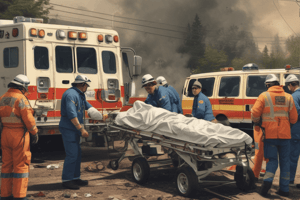Podcast
Questions and Answers
What is the first step in the triage decision tool for adults and children aged 12 to 18?
What is the first step in the triage decision tool for adults and children aged 12 to 18?
- Assess other circumstances/patient presentation and history
- Assess the anatomy of injury/injuries
- Assess vital signs and level of consciousness (correct)
- Pre-alert via PD09
Which condition requires a pre-alert according to STEP 2 of the triage decision tool?
Which condition requires a pre-alert according to STEP 2 of the triage decision tool?
- Burns or scalds >30% TBSA (correct)
- GCS < 14
- Respiratory rate < 10 breaths per minute
- Sustained systolic blood pressure < 90mmHg
What is indicated if a patient's airway becomes unmanageable?
What is indicated if a patient's airway becomes unmanageable?
- Wait for HEMS support on-site
- Divert to the nearest trauma unit (correct)
- Contact the ambulance team for reassessment
- Continue with the original triage plan
Which of the following situations would NOT prompt a pre-alert via PD09?
Which of the following situations would NOT prompt a pre-alert via PD09?
Which of the following injuries needs an immediate pre-alert under STEP 2?
Which of the following injuries needs an immediate pre-alert under STEP 2?
Flashcards are hidden until you start studying
Study Notes
Triage Decision Tool: Adults & Children (12 - 18 years)
Vital Signs and Consciousness Assessment
- Assess vital signs using the Glasgow Coma Scale (GCS); a score below 14 prompts action.
- A sustained systolic blood pressure lower than 90 mmHg indicates critical condition.
- Abnormal respiratory rates, either below 10 or above 29 breaths per minute, require immediate evaluation.
- A "Yes" response to any assessment criterion necessitates pre-alert via PD09 and activation of Major Trauma Centre (MTC) protocols.
Anatomy of Injury/ Injurie Assessment
- Severe chest wall injuries with respiratory compromise signify urgency for intervention.
- Traumatic proximal amputations (above wrist or ankle) require critical care.
- Penetrating trauma between the head and knees, which includes the axilla but excludes the arms, is concerning.
- Any arterial bleed necessitating a tourniquet indicates critical status.
- Spinal trauma presenting with abnormal neurology necessitates urgent assessment.
- Open fractures in upper or lower limbs, excluding wrists and toes, require immediate attention.
- Burns or scalds covering more than 30% Total Body Surface Area (TBSA) are classified as severe.
- Facial burns with complete skin loss to the lower half of the face require rapid response.
- Circumferential burns due to flame injuries indicate potential compromise of limb viability.
- Affirmative responses here also trigger pre-alert via PD09 and MTC activation.
Patient Presentation and History
- Significant clinical concerns identified by ambulance staff signal the need for discussion with Critical Healthcare Unified Business (CHUB)/Advanced Paramedic Practice Clinical Coordinator (APPCC)/Helicopter Emergency Medical Services (HEMS).
- Unmanageable airway conditions require diversion to the nearest trauma unit with pre-alert.
- Early clinical reports to HEMS or APPCC can facilitate enhanced clinical support on site.
- If the patient is eligible under Patient Group Directions (PGD) for Tranexamic Acid (TXA), administration should be performed en-route to the hospital.
Pre-alert Protocol
- C: Cad/Callsign for identification.
- A: Patient’s age to gauge care requirements.
- T: Time of injury for treatment timeline.
- M: Mechanism of injury to assess dynamics.
- I: Document injuries suspected or identified.
- S: Vital signs to monitor deterioration or stability.
- T: Treatments provided or required for effective handover.
Studying That Suits You
Use AI to generate personalized quizzes and flashcards to suit your learning preferences.




